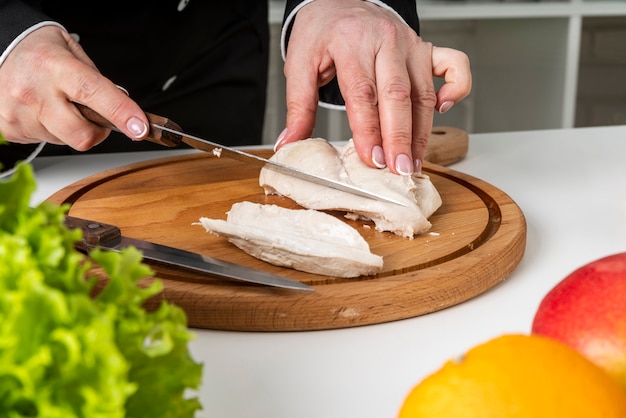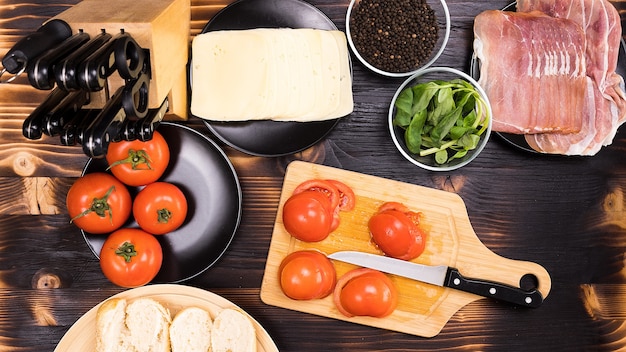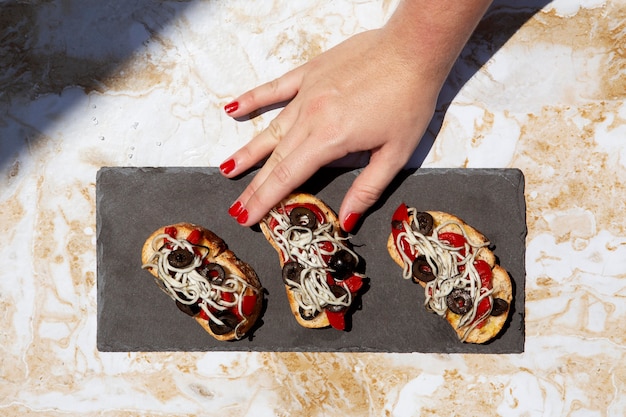There's nothing quite like sinking your teeth into a perfectly-made roast beef sandwich. The juicy, tender meat, the satisfying crunch of the bread, and the burst of flavour from the toppings – it’s a culinary masterpiece. But achieving that perfect sandwich requires a bit of know-how, and that's where this guide comes in. I'm going to walk you through everything you need to know about cooking an eye of round roast for the most amazing sandwiches you've ever tasted, even if you're a total newbie in the kitchen. So grab your apron, let's get started!
(Part 1) choosing the right cut: Eye of Round, Your New Best Friend

The first step is picking the right cut of beef. You want something that’s going to be tender and flavorful, but also relatively lean. Enter the eye of round, a cut from the hind leg of the cow that’s a real workhorse in the kitchen. It’s naturally lean, which means it’s a great option for those watching their waistlines. However, it can also get a bit dry if you’re not careful. But fear not, we’ll address that later.
What Makes Eye of Round So Great?
Eye of round is a fantastic choice for several reasons. It's relatively affordable, making it a budget-friendly option, and it's also a great choice for slicing thin, which is perfect for sandwiches. Think of it as the chameleon of roasts - it can be dressed up or down, depending on your needs. You can roast it with simple seasonings for a classic roast beef sandwich, or add some fancy herbs and spices to create something truly special.
Why Eye of Round? The Benefits in Detail
Let's break down why eye of round is such a great choice for your roast beef sandwich journey:
- Tenderness: Eye of round, when cooked correctly, has a nice tenderness that makes for a satisfying bite, especially when sliced thin for sandwiches.
- Flavor: This cut has a rich, beefy flavor that complements a wide range of sandwich toppings.
- Leanness: Eye of round is naturally lean, which is a plus for those who are watching their fat intake.
- Versatility: You can make a classic roast beef sandwich or experiment with different flavors and toppings.
- Affordability: Eye of round is generally a more affordable cut of beef compared to other popular roasts.
Things to Look For When Buying Eye of Round
Now, let's talk about picking the right eye of round. You want to look for a piece that's nice and bright red, with a good amount of marbling. Marbling is the flecks of fat running through the meat, and it’s essential for adding flavour and moisture. Avoid any cuts that have a dull colour or are excessively dry. It’s also a good idea to check the expiration date, just to be on the safe side. You don't want to be dealing with a dodgy roast!
(Part 2) Prepping for Success: The Key to a tender roast

Okay, so you’ve got your eye of round. Now it’s time to get it ready for the big show. This is where the magic happens, and it's all about ensuring your roast comes out tender and succulent. There's nothing quite like sinking your teeth into a perfectly cooked roast, so don't skip this part!
Seasoning Your Eye of Round: Keep It Simple, Keep It Delicious
First things first, seasoning. You can go wild with all sorts of fancy rubs, but honestly, a simple blend of salt, pepper, and garlic powder will do the trick. Just rub it all over the roast, making sure to get into all the nooks and crannies. For a bit of extra oomph, you can add some dried herbs like rosemary or thyme. Don't forget to pat the roast dry with paper towels before seasoning. This helps the seasoning to adhere better and creates a nice crust during cooking.
Bringing the Eye of Round to Room Temperature: The Patience Game
Now, here’s where the patience game comes in. You’ll want to let your roast sit out at room temperature for about 30 minutes before cooking. This allows the meat to cook more evenly and prevents it from getting a shock in the oven. It's like giving the roast a chance to relax before the big show. Just make sure to keep it covered with plastic wrap, to prevent any unwanted bacteria from making an appearance.
Don't Forget the Fat: A Little Help From Your Friend
Remember I mentioned eye of round being lean? Well, a little fat can go a long way in keeping it moist. Here's a little trick I learned from my mum: Before you throw the roast in the oven, rub a little bit of butter or olive oil all over it. This helps to create a nice, juicy crust and prevents the meat from drying out. Don't be shy, give it a good massage!
(Part 3) Cooking Your Eye of Round to Perfection: The Art of Low and Slow

Okay, so now we're ready to cook! Here's where the patience game really comes into play. Remember, we're aiming for a tender, juicy roast, so we need to cook it low and slow.
The Power of Low and Slow: Embrace the Time
Preheat your oven to 325°F (160°C). This is the sweet spot for cooking a roast. It allows the meat to cook through slowly and evenly, without getting tough. If you're a fan of crispier meat, you can crank up the heat to 400°F (200°C) for the last 15 minutes. But keep in mind, the longer you cook it, the more tender it will be.
cooking times: A Guide to Success
Now, let's talk cooking times. The exact time will depend on the size of your roast, but here's a general guideline:
| Size of Roast | Cooking Time |
|---|---|
| 3-4 lbs | 1 1/2-2 hours |
| 4-5 lbs | 2-2 1/2 hours |
| 5-6 lbs | 2 1/2-3 hours |
But remember, these are just guidelines. The best way to tell if your roast is done is to use a meat thermometer. You want the internal temperature to reach 145°F (63°C) for medium-rare, which is perfect for sandwiches.
Resting the Roast: A Vital Step for Juiciness
Once the roast is cooked, don't be tempted to slice it right away! You need to let it rest for at least 15 minutes before carving. This allows the juices to redistribute throughout the meat, resulting in a more tender and juicy roast. You can cover it with foil to keep it warm while it rests.
(Part 4) Slicing Your Eye of Round: The Art of the Thin Cut
Alright, your roast has rested, and now it's time for the final step - slicing it up! This is where it gets exciting. Think about it, those perfect thin slices are what make a roast beef sandwich so satisfying.
Sharpen Your Knife: A Crucial Tool
First things first, grab a sharp knife. A good, sharp knife is your best friend when it comes to slicing a roast. It makes all the difference in achieving those beautiful, thin slices. A serrated knife is a good option for slicing a roast, as it’s designed to cut through tough meat without tearing it. Just make sure it’s sharp!
The Art of Thin Slices: It's All in the Technique
Now, when slicing, you want to go against the grain of the meat. This means cutting across the muscle fibers, resulting in tender, juicy slices. You can use a cutting board or a carving rack, whatever works best for you. Don't rush it! Take your time and slice the roast into even, thin slices. Think of it as a delicate dance with your knife.
Storing Your Roast Beef: Making it Last
Once you've sliced up your roast, it's time to store it. You can keep it in the fridge for up to 3-4 days, wrapped in plastic wrap or stored in an airtight container. You can also freeze it for up to 3 months. Just remember to defrost it in the fridge overnight before using.
(Part 5) Sandwich Time! Putting It All Together
Okay, you've made it through all the hard work, and now it’s time to reap the rewards! Let's talk about building the perfect roast beef sandwich.
Choosing the Right Bread: The Foundation of Your Sandwich
First, you'll need a good base. You want a bread that can stand up to the juicy roast beef without getting soggy. I love using a hearty sourdough or a crusty baguette. But really, any bread that tickles your fancy will do.
Adding the Flavour: Your Choice of Toppings
Now for the fun part, adding those flavour bombs! There are so many options here, but I love a classic combo of horseradish sauce, mustard, and a crisp lettuce leaf. You can also add some thinly sliced red onion for a bit of tang, or some tomato for a burst of sweetness.
Finishing Touches: The Little Details that Matter
Finally, you can add some finishing touches, like a sprinkle of fresh herbs or a drizzle of olive oil. Don't be afraid to experiment and find what works best for you.
A Sandwich for Everyone: Customise Your Creation
The beauty of roast beef sandwiches is that they’re incredibly versatile. You can tailor them to your liking, adding different cheeses, pickles, or even a dollop of mayonnaise. So, go wild and create your perfect sandwich!
(Part 6) Beyond the Sandwich: Making the Most of Your Roast
Now, let's face it, you’ve likely made a big roast, and while those sandwiches are amazing, what about the rest? Don't worry, there are plenty of other ways to use up your leftover roast beef.
Roast Beef Salad: A Light and Refreshing Option
For a lighter lunch, try a roast beef salad. You can slice up the leftover roast, toss it with some greens, and top it with your favorite dressing. Add some chopped tomatoes, red onion, and a sprinkle of cheese for extra flavor.
Roast Beef Soup: A Comforting Choice
When the weather starts to turn chilly, a hearty roast beef soup is the perfect comfort food. You can use the leftover roast beef, along with some vegetables like carrots, celery, and potatoes. For extra richness, add a dollop of sour cream or a sprinkle of fresh parsley.
Roast Beef Pizza: A Creative Twist
If you’re feeling adventurous, you can even use leftover roast beef to top a pizza. Just add some sliced roast beef to your favorite pizza crust, along with your other favorite toppings.
Roast Beef Hash: A Savoury and Hearty Meal
For a satisfying breakfast or brunch, try roast beef hash. You can dice up the leftover roast beef and cook it with some potatoes, onions, and peppers. Top it with a fried egg or a dollop of sour cream for extra indulgence.
(Part 7) Tips and Tricks: Making Your Roast Even Better
Now, let’s talk about some tips and tricks to make your roast beef even better. Remember, practice makes perfect, and these little gems can help you take your roast to the next level.
Using a Meat Thermometer: The Key to Accurate Cooking
The most important tip I can give you is to use a meat thermometer. It takes the guesswork out of cooking and ensures that your roast is cooked to perfection. There’s nothing worse than a roast that’s undercooked or overcooked.
Adding Aromatics: Enhancing the Flavour
Another tip is to add some aromatics to your roast while it’s cooking. For example, you can add a few sprigs of rosemary or thyme to the roasting pan. This will infuse the meat with a lovely aroma and flavor.
Using a Roasting Rack: For Even Cooking
If you have a roasting rack, use it! It allows air to circulate around the roast, which helps it to cook more evenly. You can place the roasting rack on a baking sheet to catch any drippings.
Basting the Roast: For a Juicy Crust
While the roast is cooking, you can baste it with its own juices or with some melted butter. This helps to keep the meat moist and create a nice, crispy crust.
Adding a Marinade: For Extra Flavour
If you have time, you can marinate your roast beef before cooking it. This will infuse the meat with even more flavor. There are endless marinade options, from simple to complex, so get creative and find what you like.
(Part 8) FAQs: Your Roast Beef Questions Answered
Here are a few common questions about cooking eye of round roast:
Q1: Can I cook eye of round roast in a slow cooker?
Absolutely! A slow cooker is a fantastic option for cooking eye of round roast. Just make sure you use a slow cooker that's big enough for your roast. The low and slow cooking method in a slow cooker will result in a very tender and juicy roast. You can also add some aromatics and a little bit of liquid to the slow cooker, for extra flavor.
Q2: What can I do with the leftover drippings?
Don’t throw away those drippings! They’re packed with flavour. You can use them to make a delicious gravy for your roast beef sandwiches. Just strain the drippings through a fine-mesh sieve to remove any solids. Then, whisk in some flour and add a little bit of water or stock. Bring the mixture to a boil, stirring constantly, until the gravy thickens. You can also use the drippings to add flavor to soups, stews, or sauces.
Q3: Can I use other cuts of beef for roast beef sandwiches?
Yes! While eye of round is a great choice for roast beef sandwiches, other cuts, like top round, bottom round, and chuck roast, can also work well. Just be mindful that these cuts may be less tender than eye of round, so you may need to cook them for a longer time or use a different cooking method to ensure they're tender enough for slicing.
Q4: How can I make sure my roast beef is tender?
The key to tender roast beef is to cook it low and slow. A slow cooking method allows the muscle fibers to break down, resulting in a tender and juicy roast. You can also use a meat tenderizer to help break down the fibers, or you can try cooking the roast in a marinade.
Q5: What are some alternative toppings for roast beef sandwiches?
The possibilities are endless! You can use any toppings you like, but here are a few ideas to get your creative juices flowing:
- Cheeses: cheddar, Swiss, provolone, mozzarella, blue cheese
- Pickles: dill pickles, bread and butter pickles, sweet gherkins
- Vegetables: tomatoes, red onions, lettuce, spinach, avocado
- Spreads: mayonnaise, mustard, horseradish sauce, chimichurri sauce
Remember, the most important thing is to have fun and experiment with different flavours!
Everyone is watching

Prime Rib Roast Cooking Time Chart: Per Pound Guide
Cooking TipsPrime rib roast. Just the name conjures images of lavish dinners, crackling fires, and hearty laughter. It’s ...

How Long to Bake Potatoes in the Oven (Perfect Every Time)
Cooking TipsBaked potatoes are a staple in my kitchen. They're incredibly versatile, delicious, and surprisingly easy to m...

Perfect Rice Every Time: The Ultimate Guide to Cooking Rice
Cooking TipsAs a self-proclaimed foodie, I've always been a bit obsessed with rice. It's the foundation of countless cuisi...

The Ultimate Guide to Cooking Asparagus: Tips, Techniques, and Recipes
Cooking TipsAsparagus. The mere mention of this spring delicacy conjures up images of vibrant green spears, crisp and burs...

Ultimate Guide to Cooking the Perfect Thanksgiving Turkey
Cooking TipsThanksgiving. Just the word conjures up images of overflowing tables laden with delicious food, the scent of r...
